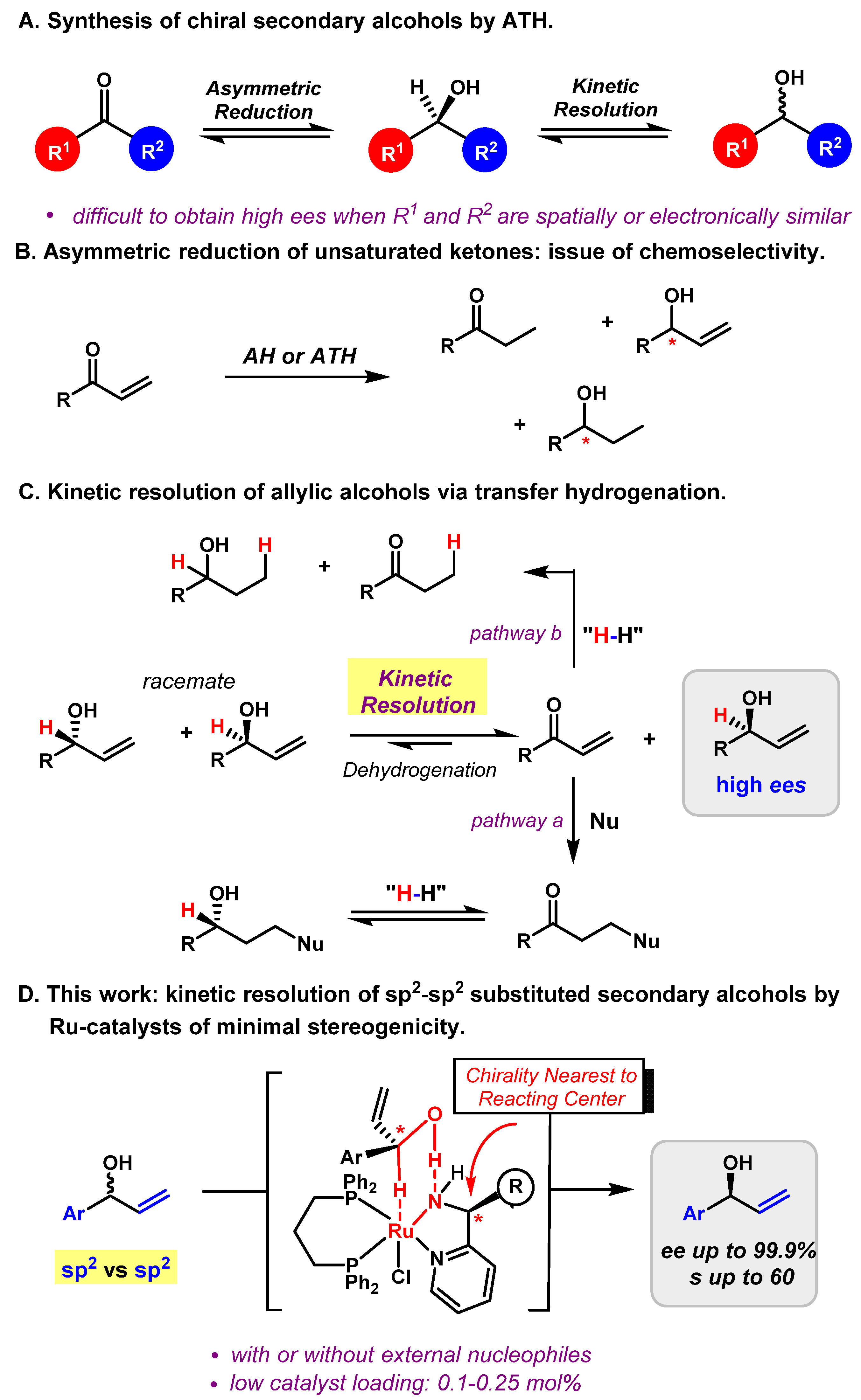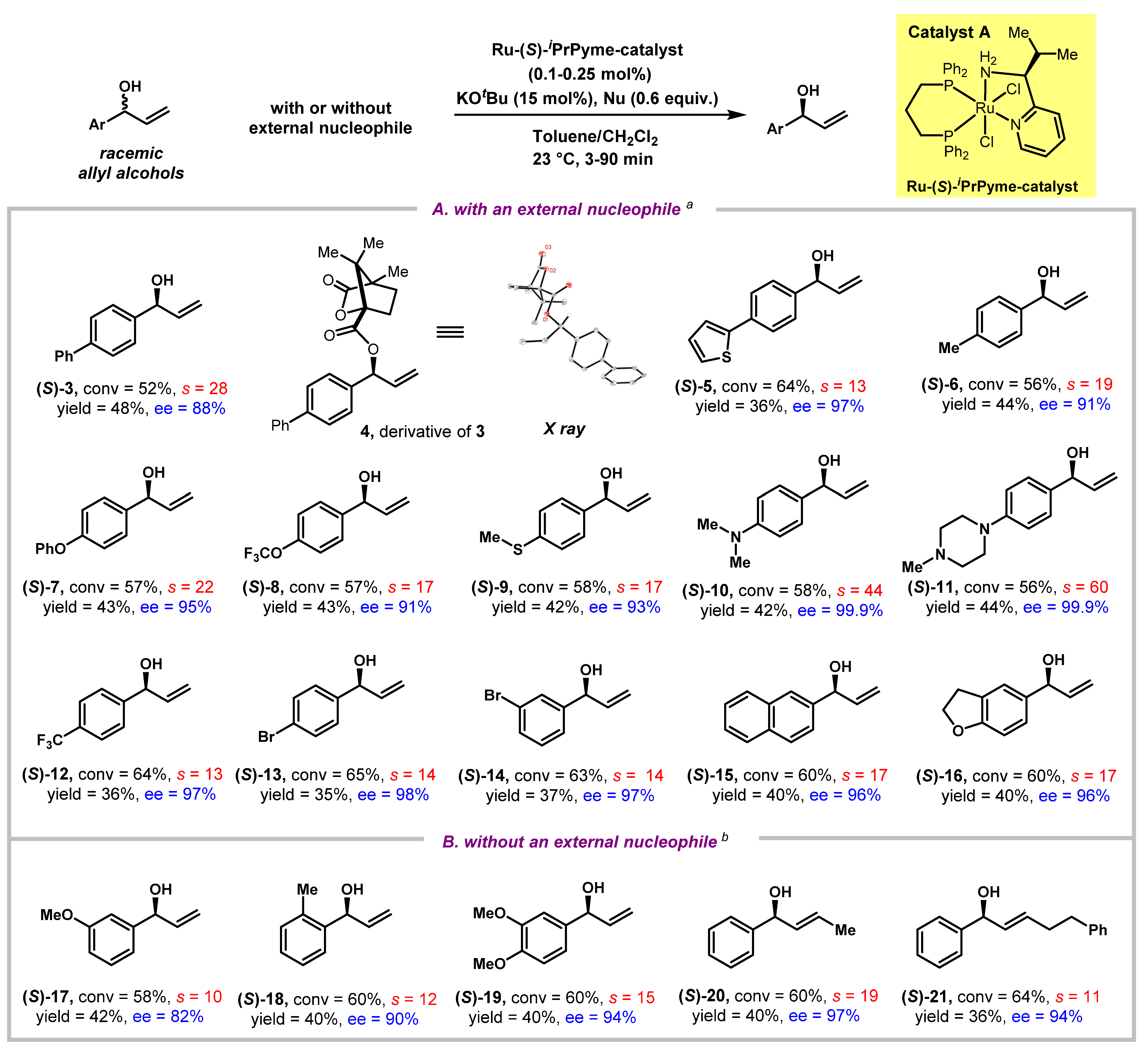Highly Efficient Kinetic Resolution of Aryl-Alkenyl Alcohols by Ru-Catalyzed Hydrogen Transfer
Abstract
:1. Introduction
2. Results and Discussion
2.1. Optimization of the Reaction Conditions
2.2. Substrate Scope for the Kinetic Resolution of Aryl-Alkenyl Alcohols
3. Materials and Methods
3.1. General Information
3.2. General Experimental Procedure for the Kinetic Resolution with or without an External Nucleophile
4. Conclusions
Supplementary Materials
Author Contributions
Funding
Institutional Review Board Statement
Informed Consent Statement
Data Availability Statement
Conflicts of Interest
Sample Availability
References
- Noyori, R.; Ohkuma, T. Asymmetric Catalysis by Architectural and Functional Molecular Engineering: Practical Chemo- and Stereoselective Hydrogenation of Ketones. Angew. Chem. Int. Ed. Engl. 2001, 40, 40–73. [Google Scholar] [CrossRef]
- Noyori, R. Asymmetric Catalysis: Science and Opportunities (Nobel Lecture). Angew. Chem. Int. Ed. Engl. 2002, 41, 2008–2022. [Google Scholar] [CrossRef]
- Noyori, R.; Kitamura, M.; Ohkuma, T. Toward efficient asymmetric hydrogenation: Architectural and functional engineering of chiral molecular catalysts. Proc. Natl. Acad. Sci. USA 2004, 101, 5356–5362. [Google Scholar] [CrossRef] [PubMed] [Green Version]
- Noyori, R.; Hashiguchi, S. Asymmetric Transfer Hydrogenation Catalyzed by Chiral Ruthenium Complexes. Acc. Chem. Res. 1997, 30, 97–102. [Google Scholar] [CrossRef]
- Palmer, M.J.; Wills, M. Asymmetric transfer hydrogenation of C=O and C=N bonds. Tetrahedron Asymmetry 1999, 10, 2045–2061. [Google Scholar] [CrossRef]
- Gladiali, S.; Alberico, E. Asymmetric transfer hydrogenation: Chiral ligands and applications. Chem. Soc. Rev. 2006, 35, 226–236. [Google Scholar] [CrossRef]
- Ikariya, T.; Blacker, J. Asymmetric Transfer Hydrogenation of Ketones with Bifunctional Transition Metal-Based Molecular Catalysts. Acc. Chem. Res. 2007, 40, 1300–1308. [Google Scholar] [CrossRef]
- Wang, D.; Astruc, D. The Golden Age of Transfer Hydrogenation. Chem. Rev. 2015, 115, 6621–6686. [Google Scholar] [CrossRef] [PubMed]
- Li, Y.Y.; Yu, S.L.; Shen, W.Y.; Gao, J.X. Iron-, Cobalt-, and Nickel-Catalyzed Asymmetric Transfer Hydrogenation and Asymmetric Hydrogenation of Ketones. Acc. Chem. Res. 2015, 48, 2587–2598. [Google Scholar] [CrossRef] [PubMed]
- Hashiguchi, S.; Fujii, A.; Takehara, J.; Ikariya, T.; Noyori, R. Asymmetric Transfer Hydrogenation of Aromatic Ketones Catalyzed by Chiral Ruthenium(II) Complexes. J. Am. Chem. Soc. 1995, 117, 7562–7563. [Google Scholar] [CrossRef]
- Hashiguchi, S.; Fujii, A.; Haack, K.J.; Matsumura, K.; Ikariya, T.; Noyori, R. Kinetic Resolution of Racemic Secondary Alcohols by RuII-Catalyzed Hydrogen Transfer. Angew. Chem. Int. Ed. Engl. 1997, 36, 288–290. [Google Scholar] [CrossRef]
- Nishibayashi, Y.; Yamauchi, A.; Onodera, G.; Uemura, S. Oxidative Kinetic Resolution of Racemic Alcohols Catalyzed by Chiral Ferrocenyloxazolinylphosphine−Ruthenium Complexes. J. Org. Chem. 2003, 68, 5875–5880. [Google Scholar] [CrossRef]
- Li, Y.Y.; Zhang, X.Q.; Dong, Z.R.; Shen, W.Y.; Chen, G.; Gao, J.X. Kinetic Resolution of Racemic Secondary Alcohols Catalyzed by Chiral Diaminodiphosphine−Ir(I) Complexes. Org. Lett. 2006, 8, 5565–5567. [Google Scholar] [CrossRef] [PubMed]
- Zhang, F.H.; Zhang, F.J.; Li, M.L.; Xie, J.H.; Zhou, Q.L. Enantioselective hydrogenation of dialkyl ketones. Nat. Catal. 2020, 3, 621–627. [Google Scholar] [CrossRef]
- Arai, N.; Azuma, K.; Nii, N.; Ohkuma, T. Highly Enantioselective Hydrogenation of Aryl Vinyl Ketones to Allylic Alcohols Catalyzed by the Tol-Binap/Dmapen Ruthenium(II) Complex. Angew. Chem. Int. Ed. Engl. 2008, 47, 7457–7460. [Google Scholar] [CrossRef] [PubMed]
- Musolino, S.F.; Ojo, O.S.; Westwood, N.J.; Taylor, J.E.; Smith, A.D. Isothiourea-Catalysed Acylative Kinetic Resolution of Aryl–Alkenyl (sp2 vs. sp2) Substituted Secondary Alcohols. Chem. Eur. J. 2016, 22, 18916–18922. [Google Scholar] [CrossRef] [Green Version]
- Ohkuma, T.; Ooka, H.; Ikatiya, T.; Noyori, R. Preferential hydrogenation of aldehydes and ketones. J. Am. Chem. Soc. 1995, 117, 10417–10418. [Google Scholar] [CrossRef]
- Ohkuma, T.; Doucet, H.; Pham, T.; Mikami, K.; Korenaga, T.; Terada, M.; Noyori, R. Asymmetric Activation of Racemic Ruthenium(II) Complexes for Enantioselective Hydrogenation. J. Am. Chem. Soc. 1998, 120, 1086–1087. [Google Scholar] [CrossRef]
- Ohkuma, T.; Koizumi, K.; Doucet, H.; Pham, T.; Kozawa, M.; Murata, K.; Katayama, E.; Yokozawa, T.; Ikariya, T.; Noyori, R. Asymmetric Hydrogenation of Alkenyl, Cyclopropyl, and Aryl Ketones. RuCl2(xylbinap)(1,2-diamine) as a Precatalyst Exhibiting a Wide Scope. J. Am. Chem. Soc. 1998, 120, 13529–13530. [Google Scholar] [CrossRef]
- Corey, E.J.; Helal, C.J. Reduction of Carbonyl Compounds with Chiral Oxazaborolidine Catalysts: A New Paradigm for Enantioselective Catalysis and a Powerful New Synthetic Method. Angew. Chem. Int. Ed. Engl. 1998, 37, 1986–2012. [Google Scholar] [CrossRef]
- Zhang, Q.Q.; Xie, J.H.; Yang, X.H.; Xie, J.B.; Zhou, Q.L. Iridium-Catalyzed Asymmetric Hydrogenation of α-Substituted α,β-Unsaturated Acyclic Ketones: Enantioselective Total Synthesis of (−)-Mesembrine. Org. Lett. 2012, 14, 6158–6161. [Google Scholar] [CrossRef] [PubMed]
- Bizet, V.; Pannecoucke, X.; Renaud, J.L.; Cahard, D. Ruthenium-Catalyzed Redox Isomerization of Trifluoromethylated Allylic Alcohols: Mechanistic Evidence for an Enantiospecific Pathway. Angew. Chem. Int. Ed. Engl. 2012, 51, 6467–6470. [Google Scholar] [CrossRef]
- Lu, S.M.; Gao, Q.; Li, J.; Liu, Y.; Li, C. A robust Ru-PNNP catalyst system for the asymmetric hydrogenation of α,β-unsaturated ketones to allylic alcohol. Tetrahedron Lett. 2013, 54, 7013–7016. [Google Scholar] [CrossRef]
- Chen, X.; Zhou, H.; Zhang, K.; Li, J.; Huang, H. Highly Enantioselective Hydrogenation of Steric Hindrance Enones Catalyzed by Ru Complexes with Chiral Diamine and Achiral Phosphane. Org. Lett. 2014, 16, 3912–3915. [Google Scholar] [CrossRef] [PubMed]
- Wu, M.; Kong, L.Y.; Wang, K.W.; Jin, R.H.; Cheng, T.Y.; Liu, G.H. Enantioselective 1,2-reductions of β-trifluoromethylated-α,β-unsaturated ketones to chiral allylic alcohols over organoruthenium-functionalized mesoporous silica nanospheres. Catal. Sci. Technol. 2015, 5, 1750–1757. [Google Scholar] [CrossRef]
- Chen, F.; Zhang, Y.; Yu, L.; Zhu, S. Enantioselective NiH/Pmrox-Catalyzed 1,2-Reduction of α,β-Unsaturated Ketones. Angew. Chem. Int. Ed. Engl. 2017, 56, 2022–2025. [Google Scholar] [CrossRef]
- Császár, Z.; Szabó, E.Z.; Bényei, A.C.; Bakos, J.; Farkas, G. Chelate ring size effects of Ir(P,N,N) complexes: Chemoselectivity switch in the asymmetric hydrogenation of α,β-unsaturated ketones. Catal. Commun. 2020, 146, 106128. [Google Scholar] [CrossRef]
- Martin, V.S.; Woodard, S.S.; Katsuki, T.; Yamada, Y.; Ikeda, M.; Shapless, K.B. Kinetic resolution of racemic allylic alcohols by enantioselective epoxidation. A route to substances of absolute enantiomeric purity? J. Am. Chem. Soc. 1981, 103, 6237–6240. [Google Scholar] [CrossRef]
- Gao, Y.; Hanson, R.M.; Klunder, J.M.; Masamune, S.Y.K.H.; Sharpless, K.B. Catalytic asymmetric epoxidation and kinetic resolution: Modified procedures including in situ derivatization. J. Am. Chem. Soc. 1987, 109, 5765–5780. [Google Scholar] [CrossRef]
- Kitamura, M.; Kasahara, I.; Manabe, K.; Noyori, R. Kinetic resolution of racemic allylic alcohols by BINAP-ruthenium(II) catalyzed hydrogenation. J. Org. Chem. 1988, 53, 708–710. [Google Scholar] [CrossRef]
- Carlier, P.R.; Mungall, W.S.; Schröder, G.; Sharpless, K.B. Enhanced kinetic resolution and enzyme-like shape selectivity. J. Am. Chem. Soc. 1988, 110, 2978–2979. [Google Scholar] [CrossRef]
- Ruble, J.C.; Latham, H.A.; Fu, G.C. Effective Kinetic Resolution of Secondary Alcohols with a Planar−Chiral Analogue of 4-(Dimethylamino)pyridine. Use of the Fe(C5Ph5) Group in Asymmetric Catalysis. J. Am. Chem. Soc. 1997, 119, 1492–1493. [Google Scholar] [CrossRef]
- Bellemin-Laponnaz, S.; Tweddell, J.; Ruble, J.C.; Breitling, F.M.; Fu, G.C. The kinetic resolution of allylic alcohols by a non-enzymatic acylation catalyst; application to natural product synthesis. Chem. Commun. 2000, 12, 1009–1010. [Google Scholar] [CrossRef]
- Córdova, A.; Tremblay, M.R.; Clapham, B.; Janda, K.D. A Sequential Application of Kinetic Resolution and Polymer-Supported Scavenging for the Isolation of Chiral Secondary Alcohols. J. Org. Chem. 2001, 66, 5645–5648. [Google Scholar] [CrossRef]
- Vedejs, E.; MacKay, J.A. Kinetic Resolution of Allylic Alcohols Using a Chiral Phosphine Catalyst. Org. Lett. 2001, 3, 535–536. [Google Scholar] [CrossRef]
- Tiecco, M.; Testaferri, L.; Santi, C.; Tomassini, C.; Bonini, R.; Marini, F.; Bagnoli, L.; Temperini, A. A Chiral Electrophilic Selenium Reagent To Promote the Kinetic Resolution of Racemic Allylic Alcohols. Org. Lett. 2004, 6, 4751–4753. [Google Scholar] [CrossRef]
- Bagdanoff, J.T.; Stoltz, B.M. Palladium-Catalyzed Oxidative Kinetic Resolution with Ambient Air as the Stoichiometric Oxidation Gas. Angew. Chem. Int. Ed. Engl. 2004, 43, 353–357. [Google Scholar] [CrossRef]
- Fernández-Zúlmel, M.A.; Lastra-Barreira, B.; Scheele, M.; Díez, J.; Crochet, P.; Gimeno, J. Chiral phosphonite, phosphite and phosphoramiditeη6-arene-ruthenium(ii) complexes: Application to the kinetic resolution of allylic alcohols. Dalton Trans. 2010, 39, 7780–7785. [Google Scholar] [CrossRef] [Green Version]
- Ren, K.; Zhang, L.; Hu, B.; Zhao, M.; Tu, Y.; Xie, X.; Zhang, T.Y.; Zhang, Z. Cationic-Rhodium-Catalyzed Kinetic Resolution of Allylic Alcohols through a Redox Isomerization Reaction in a Noncoordinating Solvent. ChemCatChem 2013, 5, 1317–1320. [Google Scholar] [CrossRef]
- Yan, L.; Xu, J.K.; Huang, C.F.; He, Z.Y.; Xu, Y.N.; Tian, S.K. Kinetic Resolution of Racemic Allylic Alcohols by Catalytic Asymmetric Substitution of the OH Group with Monosubstituted Hydrazines. Chem. Eur. J. 2016, 22, 13041–13045. [Google Scholar] [CrossRef] [PubMed]
- Chen, F.; He, D.; Chen, L.; Chang, X.Y.; Wang, D.Z.; Xu, C.; Xing, X. Chirality-Economy Catalysis: Asymmetric Transfer Hydrogenation of Ketones by Ru-Catalysts of Minimal Stereogenicity. ACS Catal. 2019, 9, 5562–5566. [Google Scholar] [CrossRef]
- He, D.; Xu, X.; Lu, Y.; Zhou, M.J.; Xiang, X. Asymmetric Transfer Hydrogenation of Densely Functionalized Diheteroaryl and Diaryl Ketones by a Ru-Catalyst of Minimal Stereogenicity. Org. Lett. 2020, 22, 8458–8463. [Google Scholar] [CrossRef] [PubMed]
- Pan, Y.; You, Y.; He, D.; Chen, F.; Chang, X.; Jin, M.Y.; Xing, X. Asymmetric Synthesis of γ-Secondary Amino Alcohols via a Borrowing-Hydrogen Cascade. Org. Lett. 2020, 22, 7278–7283. [Google Scholar] [CrossRef]
- Jin, M.Y.; Zhou, Y.; Xiao, D.; You, Y.; Zhen, Q.; Tao, G.; Yu, P.; Xing, X. Simultaneous Kinetic Resolution and Asymmetric Induction within a Borrowing Hydrogen Cascade Mediated by a Single Catalyst. Angew. Chem. Int. Ed. Engl. 2021. [Google Scholar] [CrossRef]
- Keith, J.M.; Larrow, J.F.; Jacobsen, E.N. Practical Considerations in Kinetic Resolution Reactions. Adv. Synth. Catal. 2001, 343, 5–26. [Google Scholar] [CrossRef]
- Hawkins, J.M.; Meyer, A. Optically Active Carbon: Kinetic Resolution of C76 by Asymmetric Osmylation. Science 1993, 260, 1918–1920. [Google Scholar] [CrossRef] [PubMed]



Publisher’s Note: MDPI stays neutral with regard to jurisdictional claims in published maps and institutional affiliations. |
© 2021 by the authors. Licensee MDPI, Basel, Switzerland. This article is an open access article distributed under the terms and conditions of the Creative Commons Attribution (CC BY) license (https://creativecommons.org/licenses/by/4.0/).
Share and Cite
You, Y.; Jin, M.Y.; Tao, G.; Xing, X. Highly Efficient Kinetic Resolution of Aryl-Alkenyl Alcohols by Ru-Catalyzed Hydrogen Transfer. Molecules 2021, 26, 7475. https://doi.org/10.3390/molecules26247475
You Y, Jin MY, Tao G, Xing X. Highly Efficient Kinetic Resolution of Aryl-Alkenyl Alcohols by Ru-Catalyzed Hydrogen Transfer. Molecules. 2021; 26(24):7475. https://doi.org/10.3390/molecules26247475
Chicago/Turabian StyleYou, Yipeng, Ming Yu Jin, Guanyu Tao, and Xiangyou Xing. 2021. "Highly Efficient Kinetic Resolution of Aryl-Alkenyl Alcohols by Ru-Catalyzed Hydrogen Transfer" Molecules 26, no. 24: 7475. https://doi.org/10.3390/molecules26247475
APA StyleYou, Y., Jin, M. Y., Tao, G., & Xing, X. (2021). Highly Efficient Kinetic Resolution of Aryl-Alkenyl Alcohols by Ru-Catalyzed Hydrogen Transfer. Molecules, 26(24), 7475. https://doi.org/10.3390/molecules26247475




